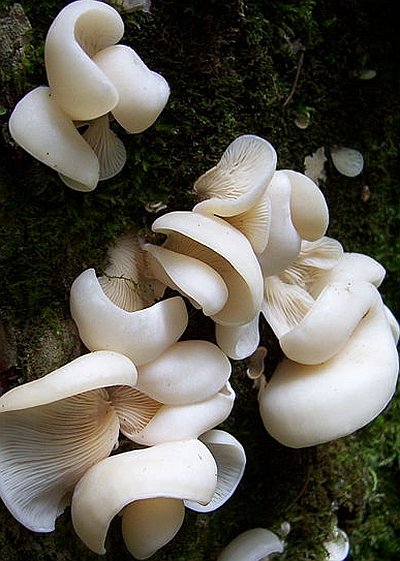Angel’s wings, Pleurocybella porrigens (Pers) Singer.
Synonyms
Agaricus porrigens Pers.
Observ. mycol. (Lipsiae) 1: 54 (1796)
Nothopanus porrigens (Pers.) Singer
Beih. Sydowia 7: 19 (1973)
Phyllotus porrigens (Pers.) P. Karst.
Bidr. Känn. Finl. Nat. Folk 32: 92 (1879)
Pleurotellus porrigens (Pers.) Kühner & Romagn.
Fl. Analyt. Champ. Supér. (Paris): 74 (1953)
Pleurotus albolanatus Peck, in Kauffman
Publications Mich. geol. biol. Surv., Biol. Ser. 5 26: 672 (1918)
Pleurotus porrigens (Pers.) P. Kumm.
Führ. Pilzk. (Zwickau): 104 (1871)
Classification
Kingdom Fungi
Phylum Basidiomycota
Class Basidiomycetes
Order Agaricales
Family Tricholomataceae
Genus Pleurocybella
Common names
Angel’s wings
Kridthat (Danish)
Korvavinokas (Finnish)
Pleurote étalé (French)
Ohrförmiger Seitling (German)
Żagiew łuskowata (Polish)
Hlivec biely (Slovak)
Hlíva ušatá (Czech)
Öronmussling (Swedish)
Krittostersopp (Norwegian)
Sugihiratake (Japanese)

My name is Austin Collins.
I've dedicated my life to Mushrooms.
I believe Mushrooms are the best kept secret when it comes to health and well being.
For that reason, I would like to share a company with you that in my opinion makes the best mushroom products on the market.
The company is called Noomadic Herbals, my favorite supplement they make is called "Mushroom Total".
I take their products every day and they have helped me think better and have more energy. Give them a try.
-Austin
Description
Fruiting body: 5-10 cm diameter, convex, shell- or petal- or fan-shaped (pleurotoid), white, minutely hairy, margin inrolled at first.
Stem: sessile.
Gills: decurrent, long, crowded, narrow, white to cream color.

Sporeprint: white.
Spores: subglobose to globose, with droplets, smooth, thin-walled, nonamyloid, 5-7 x 5-6.5 µm.
Odor: not distinctive.
Taste: not distinctive.
Edibility: Arora (and most others, prior to 2004) lists them as edible, although he writes “… but in my humble fungal opinion, bland and insubstantial.” The mushroom had no reported cases of toxicity until August 2004, when the mushroom was known to have caused encepalopathy in patients with chronic kidney diseases in northern Japan (Gejyo et al., 2005; Kato et al., 2004; Nomoto et al., 2007). Experiments additionally showed that hot water extracts, administered intraperitoneally, were toxic to nephrotic mice (strains C57BL/6N and C57BL/6J) (Takano et al., 2005), and that the toxic agents may have been vitamin D-like compounds interfering with calcium metabolism (Sasaki et al., 2006).
Habitat: found as overlapping clusters on decaying coniferous wood, especially pine; later summer and fall.
Based on analysis of genetic relationships and ITS sequences, there are at least two genetically different populations of P. porrigens in Japan (Matsumoto et al., 2005).
Bioactive compounds
The unusual long-chain fatty acid, α-eleostearic acid, appears to be a characteristic fatty acid of P. porrigens. Other free long-chain fatty acids detected by HPLC were oleic acid, and common saturated long-chain fatty acids such as linoleic acid, palmitic acid, and stearic acid (Amakura et al., 2006a).

Other conjugated long-chain fatty acids isolated from this mushroom include (14RS)-(10E,12E)- 14-hydroxy-9-oxo- 10,12-octadecadienoic acid, (12RS)-(8E,10E)- 12-hydroxy-7-oxo-8,10- octadecadienoic acid, (10E,12E)- 9,14-dioxo-10,12- octadecadienoic acid and (8E,10E)- 7,12-dioxo-8,10- octadecadienoic acid (ostopanic acid) (Amakura et al., 2006b).
The novel conjugated ketonic fatty acid, named porrigenic acid (shown below), was isolated as a cytotoxic constituent of P. porrigens. Porrigenic acid was cytotoxic against human myeloma THP-1 cells (IC50 value of 46.5 µg/ml), but did not show any significant toxicity against mouse B16F1 melanoma (Hasegawa et al., 2007).

The amino acid derivative β-hydroxy-L-valine has been isolated from fruiting bodies of P. porrigens (Aoyagi and Sugahara, 1988).
Lectins
Extracts from P. porrigens hemagglutinated human red blood cells, and this was shown to caused by anti-H-like agglutinins (Furukawa et al., 1995).
Medicinal properties
Antitumor effects
Polysaccharides extracted from the mycelial culture of P. porrigens and administered intraperitoneally into white mice at a dosage of 300 mg/kg inhibited the growth of Sarcoma 180 and Ehrlich solid cancers by 100% and 90%, respectively (Ohtsuka et al., 1973).
Links
- www.hlasek.com has pictures, while the Fungi on Wood site has pictures and description
References
Amakura Y, Kondo K, Akiyama H, Ito H, Hatano T, Yoshida T, Maitani T.
Characteristic long-chain fatty acids of Pleurocybella porrigens.
Shokuhin Eiseigaku Zasshi. 2006a 47(4):178-81.
Amakura Y, Kondo K, Akiyama H, Ito H, Hatano T, Yoshida T, Maitani T.
Conjugated ketonic fatty acids from Pleurocybella porrigens.
Chem Pharm Bull. 2006b 54(8):1213-5.
Aoyagi Y, Sugahara T.
β-Hydroxy-L-valine from Pleurocybella porrigens.
Phytochem. 1988 27(10):3306-7.
Arora D. (1990).
Mushrooms demystified. (2nd ed.)
Berkeley: Ten speed press. (959 pp)
Furukawa K, Ying R, Nakajima T, Matsuki T.
Hemagglutinins in fungus extracts and their blood group specificity.
Exper Clin Immunogen. 1995 12(4):223-31.
Gejyo F, Homma N, Higuchi N, Ataka K, Teramura T, Alchi B, Suzuki Y, Nishi S, Narita I.
A novel type of encephalopathy associated with mushroom Sugihiratake ingestion in patients with chronic kidney diseases.
Kidney Int. 2005 68(1):188-92.
Hasegawa T, Ishibashi M, Takata T, Takano F, Ohta T.
Cytotoxic fatty acid from Pleurocybella porrigens.
Chem Pharm Bull. 2007 55(12):1748-9.
Kato T, Kawanami T, Shimizu H, Kurokawa K, Sato H, Nakajima K, Nomoto T, Seta T, Kamei T, Yoshino H, Sasagawa I, Ito M, Karasawa S, Kimura H, Suzuki Y, Degawa N, Tagawa A, Ataka K, Ando S, Omae T, Shikama Y.
An outbreak of encephalopathy after eating autumn mushroom (Sugihiratake; Pleurocybella porrigens) in patients with renal failure : A clinical analysis of ten cases in Yamagata, Japan.
Brain and Nerve (Tokyo). 2004 56(12):999-1007.
Matsumoto T, Nagasawa E, Fukumasa-Nakai Y.
Variation of ITS sequences in a natural Japanese population of Pleurocybella porrigens.
Mycoscience. 2005 46(6):370-5.
Nomoto T, Seta T, Nomura K, Shikama Y, Katagiri T, Katsura K-i, Kato T, Katayama Y.
A case of reversible encephalopathy accompanied by demyelination occurring after ingestion of sugihiratake mushrooms.
Nippon Ika Daigaku Zasshi. Journal of the Nippon Medical School (Tokyo) 2007 74(3):261-4.
Ohtsuka S, Ueno S, Yoshikumi C, Hirose F, Ohmura Y, Wada T, Fujii T, Takahashi E.
Polysaccharides having an anticarcinogenic effect and a method of producing them from species of Basidiomycetes.
UK Patent 1331513, 26 September 1973.
Sasaki H, Akiyama H, Yoshida Y, Kondo K, Amakura Y, Kasahara Y, Maitani T.
Sugihiratake mushroom (Angel’s Wing Mushroom)-induced cryptogenic encephalopathy may involve vitamin D analogues.
Biol Pharm Bull. 2006 29(12):2514-8.
Singer R.
New Genera of Fungi. III
Mycologia. 1947 39(1):77-89.
Takano F, Yamaguchi M, Shoda S, Fu Z-D, Ohta T.
Toxicological studies on hot water extracts of Pleurocybella porrigens (Pers.:Fr.) in mice.
Nat Med. 2005 59(4):151-6.
Toyoshima I, Obara K, Watanabe S, Sato S, Gonmori K.
Striatal necrosis and cerebral cortical lesion in acute encephalopathy related to mushroom, Pleurocybella porrigens.
J Neuro Sci. 2005 238(Suppl. 1):S181.


